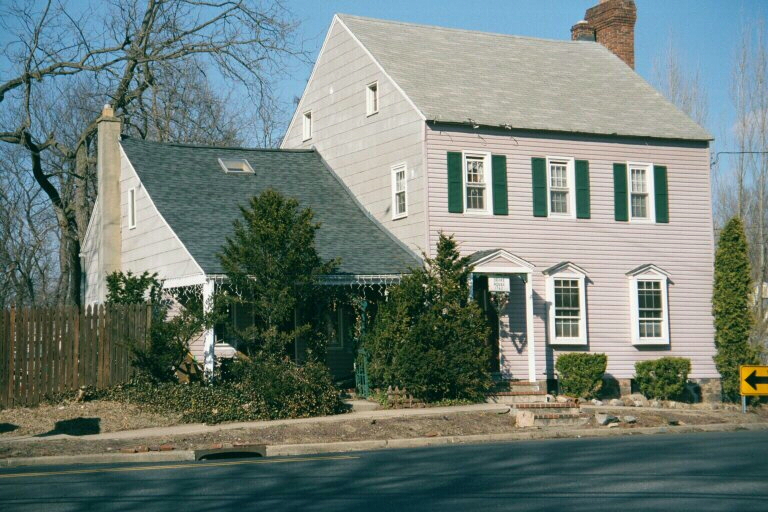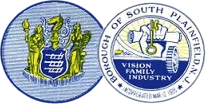| Quick Links | ||||||||||||||||||||||||
| ||||||||||||||||||||||||
History of South Plainfield
Incorporated March 12, 1926
Prehistoric to Revolutionary Times in South Plainfield
To a large extent South Plainfield’s landscape was formed thousands of years ago by a Glacier. As the Glacier inched across the borough from the direction of New Durham Avenue towards Woodland Avenue it picked up soil along the way. As a result the two highest points in our town are where the Glacier started (Durham Avenue near what is now the Prudential/Motorola building) and where it began to melt (Woodland Avenue near the West Nine Golf Course). In the middle a flat basin was formed near what is now Spring Lake. That is why all the good topsoil is on the north side of town and the soil content on the south side is shale. The landscape became important as prehistoric hunters arrived on the scene. They used the high points near Woodland Avenue and Durham Avenue as lookouts for the animals that grazed in the lower areas of town. South Plainfield remained a fertile hunting ground right up to the time of the Lenape Indians. A tribe of these Native Americans who lived here were called “Raritaing” from which the name “Raritan” was derived.
The area that later became South Plainfield was included in the “Elizabethtown Purchase” of 1664 as a part of Piscataway Township. The name “Piscataway” came from the “Piscataqua” Indians of Maine. (Remember the early settlers were originally from New England). Piscataway Township encompassed all of the land from Woodbrige to the southern most part of Middlesex County, including what later became New Brunswick, Spotswood, Millstone, Princeton and Cranbury. Most of the first settlers were of Scottish descent although some Quakers also lived here.
Logging was a significant industry of the time and a major operation was established along the Cedar Brook where a sawmill and gristmill were started in 1732.

Two hamlets developed in the mid 1700’s. “Sampton” was located at the junction of what is now Sampton and Clinton Avenues, which was the main road from Elizabeth to New Brunswick. In the late 1700’s, a tavern was established to serve travelers at what is now 746 Sampton Avenue (the Drake house).
The second hamlet was called “Brooklyn” and it was located at Front Street and South Plainfield Avenue. Brooklyn is where the families of the men who worked at the gristmill and the sawmill on the Bound Brook lived. The remaining land in South Plainfield was occupied by what then was considered small farms of less than two hundred acres.
South Plainfield During the Revolutionary War
This area of New Jersey was occupied by the British from December 2, 1776 to June 22, 1777. Much activity took place in this vicinity during the spring and summer of 1777. There were continuing British and Continental Army movements between Perth Amboy and New Brunswick. It is documented that General Washington and his troops had an encampment in the New Market section of Piscataway and it is believed that British troops led by General Cornwallis moved towards General Washington and likely crossed Spring Lake on an old log road. In response, Washington sought a higher vantage point to view British troop movements and relocated his regiment to what became known as “Washington Rock”.
In 1834 there were 8 to 10 dwellings in Brooklyn and 10 to 12 dwellings in Sampton where the tavern and store were located. Samptown School had over 100 students. Girls could only attend “at such hours as would not interrupt the boys studies.”
We got our first post office in 1877 under the name of “New Brooklyn”. It was changed to South Plainfield about ten years later. Not because that was the name of our town, but it was because of our proximity to Plainfield, which was a leading economic and social force in central New Jersey. The Lehigh Valley Railroad extended its line here for the same reason. The railroad established a storage yard and repair shop and along with it came its laborers who were mostly Irish immigrants. Many of them settled in town increasing the population of mostly blue-collar factory workers and craftsmen.

In 1879 The First Baptist Church of South Plainfield was forced to relocate from its former site on Sampton Avenue due to a fire. Construction began on the new church and rectory. Today these buildings are still located on Hamilton Boulevard.
In 1907, the Lehigh Volunteer Fire Department of South Plainfield was organized. The fire brigade had no equipment so the firemen themselves purchased buckets, axes, bars, hoops, rope and a 35 foot ladder. They even purchased the old Webster house garage on Hamilton Boulevard for a firehouse. That location, which is now occupied by a dance studio, frame shop and convenience store, remained the site of the municipal building and fire department until the 1960’s. In order to raise needed funds, the firehouse was leased to Piscataway
Township during election times and the upstairs rooms were rented to the Piscataway Board of Education for classrooms. The upstairs eventually became the municipal building where the court met and council meetings were held.
In 1913 the Spicer Manufacturing Company constructed a factory near the railroad station on the old Elliot Farm. That later became the site of Cornell-Dublier and is now known as the Hamilton Boulevard Industrial tract.
In 1915 George Harris established Harris Structural Steel on the former Blackford farm on New Brunswick Avenue where it became one of the largest steel manufacturers in the country during World War II. As a result of these industries, South Plainfield began its transformation from a sleepy farming town into a suburban industrial community. The residents agreed that the time had come to establish a town of their own.
South Plainfield Is Born!
During the 1920’s South Plainfield, which was still a part of Piscataway Township, began to acquire an identity of its own. The area known as New Brooklyn became the center of town. There was an Atlantic & Pacific Grocery Store (A&P), Pass’s Drug Store, Nischwitz Feed & Grain, Randolph’s butcher shop, and Vail’s General Store. There was a pig farm in the Dismal Swamp and there was even a movie theatre, owned by the DeSabato family. The school population was growing so fast that a new school was built next to the Baptist Church and was named Grant School after the Civil War Hero.
In 1924, an airport was built on John Hadley’s farm mainly for the use of the U.S. Postal Service. The first night airmail flight took off on July 1, 1925 and it took only 33 ½ hours to fly coast to coast. There were Sunday afternoon air shows announced by a young man who later became Mayor Henry Apgar. Bendix Aviation experimental planes and helicopters were tested at Hadley Airport.
After receiving permission from Piscataway Township and the State of New Jersey, South Plainfield was officially incorporated on March 12, 1926. Mayor William Hamilton took the oath of office from Middlesex County Clerk F. William Hilker, followed by South Plainfield’s first councilmen, Charles H. Thorton, Jr., Milton Mende, Henry Brentnall, Albert J. Dellavalle, Michael Pomponio and Robert A. Ritter.
South Plainfield’s development was thwarted by the onset of the Great Depression. During the 1930’s most residents managed to survive as farmers, day laborers or W.P.A. workers who were paid by the federal government to build roads, bridges and sewers. People did what they had to in order to survive. They repaired their shoes over and over, made clothes from feed sacks, raised chickens and cows, planted their own gardens and ate wild fruit and nuts for food. Maple Avenue became a walkway for the women to bring the family cow to grazing land.
No one in South Plainfield could afford a Model T, so the horse and wagon was still the only means of transportation. Bread and cakes and milk, along with ice were delivered by wagon every day. Dry goods were offered once a week and the junk man also came around every week or so. Knife and scissor sharpeners came once a month. What was not eaten was used as fertilizer in the garden…(recycling at its best). The small amount of garbage that did remain, was collected by little girls who came around once a week with small wagons.
South Plainfield’s prosperity began in 1936 when Cornell-Dublier moved into the Spicer Building More than half of South Plainfield’s families were employed by Cornell-Dublier which manufactured condensers for the exploding radio industry. The site was chosen because of its frontage on the railroad line.
In the 1940’s the site of the present PAL building was an amusement park and there was a lake for swimming. Post Cards of the day intoned, “Wish you were here at Holly Park!” South Plainfield was still mostly a farming town with a population of 5,300 in 1940.
South Plainfield’s suburban character was established after World War II when the Geary Farm on Plainfield Avenue was developed into what became known as Geary Park. Shortly thereafter various housing developments sprang up throughout the north side of the Borough increasing South Plainfield’s population form 8,000 in 1959 to 18,000 in 1960.
Commercial and Industrial uses were attracted to the borough in the 1960’s and 70’s. The highlights were the construction of the Golden Acres Shopping Center, the Middlesex Mall and the Prudential Building. In the bicentennial year of 1976, South Plainfield’s population was 23,000. It remains at approximately that number today.
